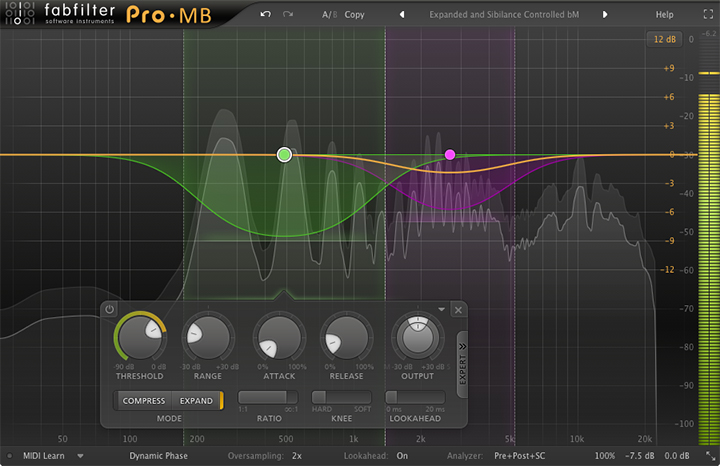Gain a better understanding of upward and downward expansion and learn how to use expanders to enhance sounds in your mix.

What are Expanders?
Expanders are helpful dynamic processing tools that increase the dynamic range of an audio signal. They are essentially the opposite of a compressor, which decreases the dynamic range of an audio signal.
There are two types of expansion: upward expansion and downward expansion. Downward expanders reduce the level of an audio signal below the threshold, making quiet sounds quieter. Upward expanders boost the level of an audio signal above the threshold, making loud sounds even louder.
Expanders often have similar controls as a compressor such as attack, release, threshold, and ratio. Many also have a range control such as FabFilter’s Pro-MB. These controls also function in the same manner as a compressor:
Attack: Sets how fast expansion responds when a signal level crosses the threshold
Release: Sets how fast the expansion recovers after a signal level crosses the threshold
Threshold: Sets the level where expansion occurs
Ratio: Sets the amount of expansion that is applied
Range: Limits the maximum amount of applied gain change
Upward Expanders

Upward expanders are often used to emphasize the peaks of an audio signal. They increase dynamic range by turning up the signal when it exceeds a set threshold. So rather than attenuating quieter sounds like a standard expander, they amplify louder sounds. The signal levels below the threshold will remain unchanged.
Upward expansion is useful for adding attack and excitement to highly dynamic sound sources like drums, percussion, synths, vocals, piano, and guitars. Think of upward expanders as advanced transient shapers.
Upward Expansion Treatment Examples
- Enhancing the punch of a kick without affecting the sub or the click
- Strengthening vocals, so they are more prominent in the mix
- Improving the clarity of hi-hats, cymbals, and other high-frequency percussive sounds
- Adding dynamic lift to a synths mids or highs, so it cuts through the mix better
- Adding subtle transient enhancement to an entire mix
- Restoring dynamics to flat and dull sounds
- Targeting specific frequencies in a sample loop. For example, adding punch to a snare in a drum loop without affecting other elements such as hi-hats or toms
Downward Expanders

The most common type of expansion is downward expansion. Downward expanders apply level reduction to an audio signal similar to a noise gate. They increase dynamic range by turning down the signal when it falls below a set threshold. So rather than amplifying louder sounds like upward expansion, they attenuate quieter sounds. The signal levels above the threshold will remain unchanged.
Downward expansion is useful for suppressing unwanted noise or bleed in a signal. Think of downward expanders as advanced noise gates.
The primary difference between a “gate” and an “expander” is the degree of level reduction that is applied. Typical noise gates are more aggressive and abruptly cut off the sound when the signal drops below the threshold. Whereas expanders are more subtle and smooth sounding because they fade levels rather than mute them. Moreover, expanders tend to sound more natural than gates because they do not completely turn off the signal. Also, expanders provide more control than gates. It’s much easier to dial in how fast the effect reacts to signal level changes with intuitive controls. In addition, some downward expanders also have a range setting, which allows you to set the maximum amount of attenuation, so it never cuts the signal off entirely.
Downward Expansion Treatment Examples
- Reducing bleed from other instruments in a recording
- Cleaning up vocal recordings
- Reducing background noise or hums in a microphone recording
- Taming reverb tails and delay echoes
- Lowering the noise from guitar amps
- Controlling the tail of drum sounds and instruments, creating more separation between notes or hits
- Tightening up the decay of kicks, snares, and other drum elements
- Isolating sounds in a sample loop
- Applying creative gating effects
- Fading out sounds
Working with Expanders
Expanders are great tools for improving clarity or bringing some punch into your music with incredible control. Expansion is also a more modern processing technique that provides flexibility and precision over the dynamics of your sounds. Furthermore, expanders can be used to treat audio in conventional ways or more creatively for sound design and effects processing. The possibilities await you!